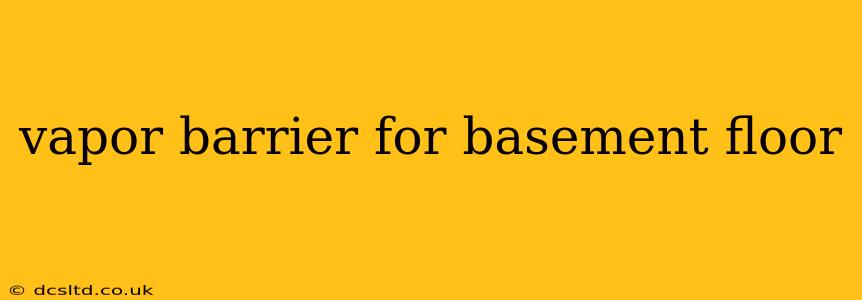A damp basement is a homeowner's nightmare, often leading to mold growth, structural damage, and unpleasant odors. A crucial step in preventing these problems is installing a proper vapor barrier on your basement floor. This comprehensive guide will delve into everything you need to know about choosing, installing, and maintaining a vapor barrier to create a dry and healthy basement environment.
What is a Vapor Barrier and Why is it Important?
A vapor barrier is a material designed to prevent moisture vapor from passing through. In a basement, this is crucial because moisture can migrate from the ground up, leading to dampness and potential problems. The ground itself often contains moisture, and without a barrier, this moisture can permeate the concrete slab and enter your basement. A properly installed vapor barrier acts as a shield, significantly reducing or eliminating this moisture migration. This is especially important in basements with high humidity levels or those situated in areas with high water tables.
What are the Different Types of Vapor Barriers for Basement Floors?
Several materials can effectively serve as vapor barriers, each with its pros and cons:
-
Polyethylene Sheeting: This is a common and relatively inexpensive option. It's easy to install but can be susceptible to tearing and punctures.
-
Visqueen: While often used interchangeably with polyethylene, Visqueen is a brand name, not a type of material. It usually refers to a type of polyethylene sheeting.
-
Asphalt-based Membranes: These offer superior strength and durability but are more expensive and more challenging to install.
-
Vapor Barrier Paint: This is a specialized paint designed to create a moisture barrier. It's easy to apply but might not provide the same level of protection as a membrane.
How to Choose the Right Vapor Barrier for Your Basement?
The best vapor barrier for your basement depends on several factors:
-
Budget: Polyethylene sheeting is the most affordable, while asphalt-based membranes are the most expensive.
-
Existing Conditions: The level of existing moisture and the overall condition of your basement floor will influence your choice.
-
Installation Skills: Some materials are easier to install than others. Asphalt membranes often require professional installation.
-
Climate: In humid climates, a higher-performing barrier like an asphalt membrane might be preferable.
How Do I Install a Vapor Barrier in My Basement?
Installing a vapor barrier is a relatively straightforward DIY project, but proper preparation is essential:
-
Clean the Floor: Remove any debris, dust, and loose materials from the basement floor.
-
Repair Cracks: Fill any cracks or gaps in the concrete floor with a suitable patching compound. This will prevent moisture from seeping through.
-
Lay the Barrier: Overlap the sheets of vapor barrier material by at least six inches and seal the overlaps with vapor-resistant tape.
-
Secure the Edges: Secure the edges of the barrier to the walls using construction adhesive or staples.
-
Add Flooring: Once the vapor barrier is installed, you can add your chosen basement flooring, such as tile, concrete, or carpeting.
What are the Signs of a Failing Vapor Barrier?
-
Musty Odor: A persistent musty smell in your basement could indicate moisture intrusion.
-
Mold Growth: Mold growth is a clear sign of excessive moisture.
-
Damp Spots: Visible dampness or water stains on the walls or floor are alarming.
-
Peeling Paint: Peeling paint is another sign of moisture damage.
Can I Install a Vapor Barrier Myself, or Should I Hire a Professional?
While you can install a polyethylene vapor barrier yourself, asphalt-based membranes typically require professional installation due to their complexity. If you're unsure, it's always best to consult a qualified contractor, especially if you're dealing with significant moisture issues.
What is the Difference Between a Vapor Barrier and a Damp Proofing Membrane?
Damp-proofing is a different process, primarily aimed at preventing water from entering the basement walls. A vapor barrier, on the other hand, focuses on preventing water vapor from migrating through the floor itself. Often, both are used together for optimal protection.
How Much Does it Cost to Install a Vapor Barrier in a Basement?
The cost varies significantly depending on the size of the basement, the chosen material, and whether you hire a professional. Materials alone can range from a few hundred to several thousand dollars. Labor costs can add substantially to the overall expense.
By understanding the different types of vapor barriers and the proper installation techniques, you can significantly improve the condition of your basement, creating a dry, healthy, and comfortable space. Remember, proactive moisture management is key to preventing costly repairs and ensuring the longevity of your home.
